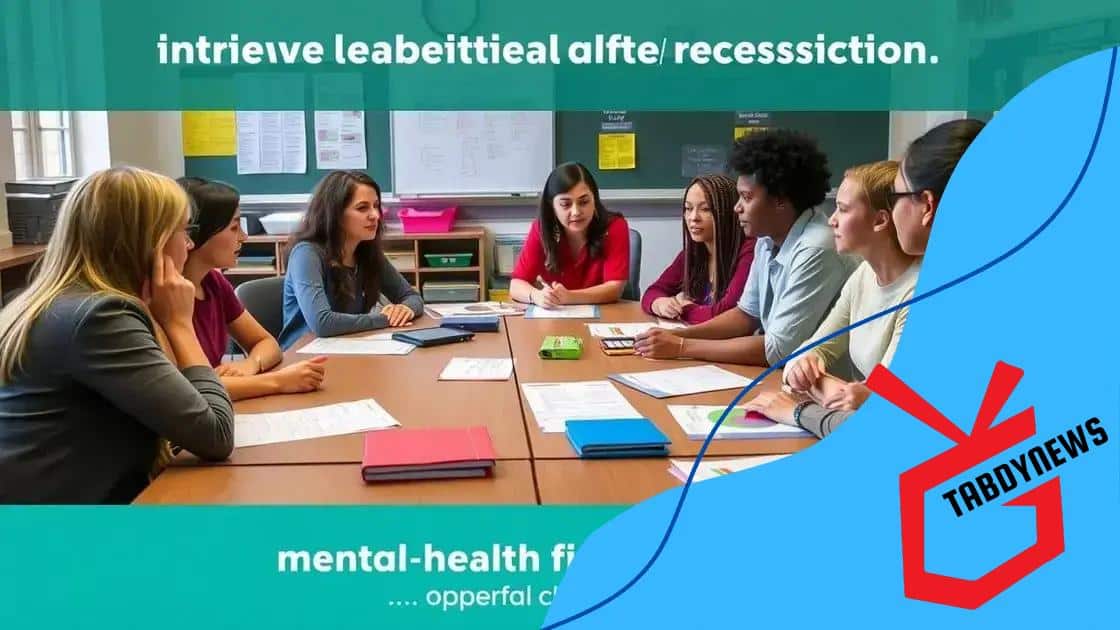The importance of mental health resources in schools

The importance of mental health resources in schools lies in their ability to enhance student well-being, improve academic performance, and foster a supportive environment where students feel safe to express their emotions and seek help.
The importance of mental health resources in schools is a topic that resonates deeply in today’s educational landscape. Have you ever wondered how these resources truly impact our students’ lives?
Understanding mental health in a school context
Understanding mental health in a school context is essential for fostering a positive environment for students. Recognizing that mental health affects learning and behavior is the first step in supporting our youth.
Schools are often the frontlines where students experience stress, anxiety, and other mental health challenges. Many students may not have access to adequate support outside of school, making it vital for educational institutions to step in.
What is Mental Health?
Mental health encompasses emotional, psychological, and social well-being. It influences how we think, feel, and act. Understanding this can help educators create supportive environments.
Signs of Mental Health Issues in Students
Students may show various signs indicating mental health difficulties, such as:
- Changes in mood or behavior
- Withdrawal from friends or activities
- Declining academic performance
- Increased absences from school
Recognizing these signs early is crucial for timely intervention. Educators can play a key role in identifying students in need of support.
Engaging students in conversations about their well-being can also reduce stigma. Schools can initiate programs that educate students about mental health and encourage them to seek help when needed.
The Role of School Staff
Teachers and staff members are often the first point of contact for students facing mental health issues. They can be trained to recognize signs and approach students compassionately. A supportive school culture fosters trust, making students feel comfortable sharing their struggles.
By recognizing the importance of mental health resources, schools can make a significant impact. This creates a better learning environment and supports students in achieving their full potential.
Benefits of mental health resources for students
Benefits of mental health resources for students are profound and far-reaching. Having access to these resources can greatly improve students’ overall well-being and academic performance.
When students know they have support, they are more likely to thrive in school. Mental health resources provide a safe space for students to express their feelings and access help when they need it. This proactive approach can make a real difference in their lives.
Improved Academic Performance
One significant benefit of mental health resources is the potential for improved academic performance. When mental health is prioritized, students are better able to focus and engage in their studies.
Support in Managing Stress
Resource availability helps students effectively manage stress and anxiety. By learning coping strategies, they can navigate challenges more easily. Some key points include:
- Developing healthy coping mechanisms
- Learning relaxation techniques
- Finding balance between school and personal life
Additionally, students gain important life skills such as resilience and emotional intelligence. This aids them not only in school but also in future endeavors.
Encouragement of Positive Relationships
Another advantage is that mental health resources foster connections among students. These resources encourage open dialogue and understanding, helping students build supportive friendships.
When students feel understood, they are more likely to engage positively with peers and staff. Strong relationships enhance the school community and create a positive learning environment.
Investing in mental health resources ultimately benefits everyone in the school. It creates a healthier, happier student body ready to learn and grow.
How schools can implement mental health programs

How schools can implement mental health programs is a crucial topic that requires careful planning and execution. By integrating mental health resources into the school environment, educators can create a supportive atmosphere for all students.
One effective approach for schools is to start by assessing the specific needs of their student population. This helps to tailor programs according to the unique challenges students face. Gathering input from students, parents, and staff can provide valuable insights.
Collaboration with Mental Health Professionals
Partnering with mental health professionals is an essential step. Schools can work with counselors, therapists, and local mental health organizations to develop effective programs. These collaborations provide expertise and resources that may not be available in-house.
Establishing Support Groups
Creating support groups within the school can help students feel less isolated. These groups allow students to share their experiences and learn from one another. Some important components of effective support groups include:
- Facilitated discussions led by trained professionals
- Creating a safe space for communication
- Encouraging open dialogue about mental health
By fostering a non-judgmental environment, schools can help students build confidence and resilience.
Training Staff Members
Training teachers and staff on mental health awareness is another vital strategy. Educators who understand mental health issues can better support students in their classroom. They can recognize signs of distress and refer students to appropriate resources when needed.
Incorporating mental health education into the curriculum is also important. Teaching students about mental health helps normalize discussions and reduces stigma. This can lead to a culture where students feel empowered to seek help.
Overall, implementing mental health programs requires commitment and collaboration. By taking proactive steps, schools can create environments that support the mental well-being of every student.
Barriers to accessing mental health resources
Barriers to accessing mental health resources can significantly impact students and their ability to receive the support they need. Understanding these barriers is key to developing effective solutions.
One major obstacle is the stigma surrounding mental health. Many students fear judgment from peers if they seek help. This stigma can prevent them from accessing valuable resources. It’s important for schools to create an environment where talking about mental health is normalized.
Lack of Awareness
Another barrier is a lack of awareness about available resources. Students may not know what mental health services their school offers or how to access them. Schools should provide clear information about resources, making it easy for students to find help.
Financial Constraints
Financial issues can also pose a significant barrier. Many families may not be able to afford mental health services outside of school. Schools can step in by offering services at no cost, ensuring all students have access.
- Providing free counseling services
- Organizing community mental health fairs
- Partnering with local clinics for reduced rates
Moreover, logistics can complicate access to resources. For instance, transportation issues may hinder students from attending appointments. Schools should consider providing resources on-site or facilitating virtual counseling to help students receive support easily.
Cultural factors can also limit access to mental health care. Some students may come from backgrounds where seeking help is discouraged. To overcome this, schools need to foster a culturally sensitive environment that respects diverse views on mental health.
Addressing these barriers requires a comprehensive approach. By understanding and tackling the challenges students face, schools can help them access necessary mental health resources.
The role of teachers in supporting mental health
The role of teachers in supporting mental health is crucial in today’s schools. Teachers are often the first line of defense in identifying students who may need help. By fostering a supportive environment, they can make a significant impact on student well-being.
Building strong relationships with students is key. When students feel comfortable with their teachers, they are more likely to share their struggles. This trust lays the foundation for open communication about mental health.
Recognizing Signs of Distress
Teachers must be trained to recognize signs of mental health issues. These may include changes in behavior, mood swings, or academic decline. By identifying these signs early, teachers can intervene and provide the necessary support.
Creating a Safe and Inclusive Environment
Creating a safe and inclusive classroom environment is essential for supporting mental health. Teachers can implement strategies to promote a sense of belonging, such as:
- Encouraging collaboration and teamwork
- Practicing active listening
- Promoting empathy and understanding among students
When students feel safe, they are more likely to engage in learning and express their feelings. This atmosphere helps reduce stigma surrounding mental health and encourages students to seek help when needed.
Additionally, teachers can incorporate mental health education into their curriculum. By discussing topics such as coping strategies, stress management, and emotional intelligence, they provide valuable tools that students can use throughout their lives.
Teachers should also work closely with school counselors and mental health professionals. Effective collaboration can ensure that students receive comprehensive support tailored to their needs. Together, they can create action plans for students who require additional assistance.
Ultimately, teachers play a vital role in promoting mental health as a part of the academic experience. Their engagement and support can lead to healthier, happier, and more resilient students.
FAQ – Frequently Asked Questions about Mental Health Resources in Schools
Why are mental health resources important in schools?
Mental health resources support students’ emotional well-being, which in turn enhances their academic performance and social interactions.
What role do teachers play in supporting student mental health?
Teachers recognize signs of mental distress, foster open communication, and create safe environments for students to express their feelings.
What barriers might students face in accessing mental health resources?
Students may encounter stigma, lack of awareness about available resources, financial constraints, and cultural factors that discourage seeking help.
How can schools effectively implement mental health programs?
Schools can collaborate with mental health professionals, establish support groups, and train staff to recognize and address mental health issues among students.





